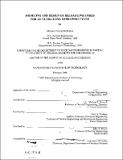| dc.contributor.advisor | Michael J. Driscoll and Neil E. Todreas. | en_US |
| dc.contributor.author | McMahon, Michael Vincent | en_US |
| dc.date.accessioned | 2010-01-07T20:41:56Z | |
| dc.date.available | 2010-01-07T20:41:56Z | |
| dc.date.copyright | 1998 | en_US |
| dc.date.issued | 1998 | en_US |
| dc.identifier.uri | http://hdl.handle.net/1721.1/50460 | |
| dc.description | Thesis (Ph. D.)--Massachusetts Institute of Technology, Dept. of Nuclear Engineering, 1998. | en_US |
| dc.description | Includes bibliographical references (p. 193-198). | en_US |
| dc.description.abstract | The purpose of this research was to use state-of-the-art nuclear and fuel performance design packages to develop extended cycle cores for existing Light Water Reactor (LWR) designs which respect current fuel burnup limits while considering the full range of practical design and economic considerations. The driving force behind this research was the desire to make nuclear power more economically competitive with fossil fuel options by permitting higher plant capacity factors. In this thesis, reference cores for a 38.8 Effective Full Power Month (EFPM) PWR cycle and a 45 EFPM BWR cycle were developed and evaluated. To achieve these cycle lengths the designs use a single batch reloading strategy and contain fuel with enrichments as high as 7.4W/0 U2 3 5 (exceeding the current licensing limit of 5W/). The PWR design uses gadolinium oxide (Gd20 3) and IFBA (Integral Fuel Burnable Absorbers - a thin fuel pellet surface coating of ZrB2) as burnable poisons to hold down excess reactivity and to control power peaking. The BWR employs only Gd203. Both core designs require higher worth control rods in order to meet shutdown safety requirements. Fuel performance issues were also investigated. The presence of high burnup fuel assemblies in areas of greater-than core-average power leads to fuel performance concerns which must be carefully addressed. The effects of waterside corrosion, increased fission gas pressure, and intensified cladding strain in these assemblies must be carefully quantified. Steady state-analyses of fuel pin internal pressure performed on the PWR design show acceptable fuel pin performance. Fuel performance areas requiring further research were highlighted. Economic calculations show that extended cycle, single batch loaded cores have a fuel cost that is $13 million to $17 million per year more expensive than an optimized multi-batch strategy. This deficit would have to be made up from the net benefits of a higher capacity factor (e.g., less replacement energy, fewer refueling outages) levelized over plant lifetime. | en_US |
| dc.description.statementofresponsibility | by Michael Vincent McMahon. | en_US |
| dc.format.extent | 238 p. | en_US |
| dc.language.iso | eng | en_US |
| dc.publisher | Massachusetts Institute of Technology | en_US |
| dc.rights | M.I.T. theses are protected by
copyright. They may be viewed from this source for any purpose, but
reproduction or distribution in any format is prohibited without written
permission. See provided URL for inquiries about permission. | en_US |
| dc.rights.uri | http://dspace.mit.edu/handle/1721.1/7582 | en_US |
| dc.subject | Nuclear Engineering | en_US |
| dc.title | Modeling and design of reload LWR cores for an ultra-long operating cycle | en_US |
| dc.title.alternative | Modeling and design of reload light water reactor cores for an ultra-long operating cycle | en_US |
| dc.type | Thesis | en_US |
| dc.description.degree | Ph.D. | en_US |
| dc.contributor.department | Massachusetts Institute of Technology. Department of Nuclear Science and Engineering | en_US |
| dc.identifier.oclc | 42139247 | en_US |
